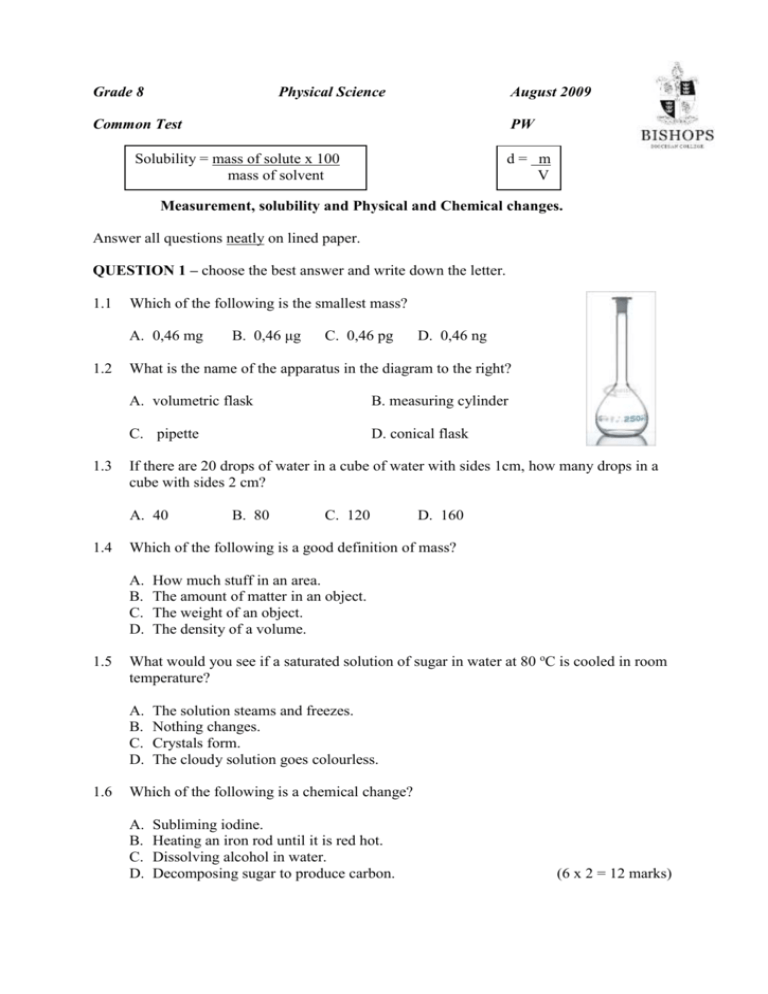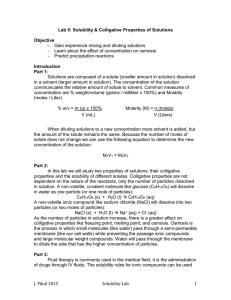Grade 8 Physical Science August 2009 Common Test PW Solubility
advertisement

Grade 8 Physical Science August 2009 Common Test PW Solubility = mass of solute x 100 mass of solvent d= m V Measurement, solubility and Physical and Chemical changes. Answer all questions neatly on lined paper. QUESTION 1 – choose the best answer and write down the letter. 1.1 Which of the following is the smallest mass? A. 0,46 mg 1.2 1.3 B. measuring cylinder C. pipette D. conical flask If there are 20 drops of water in a cube of water with sides 1cm, how many drops in a cube with sides 2 cm? B. 80 C. 120 D. 160 Which of the following is a good definition of mass? How much stuff in an area. The amount of matter in an object. The weight of an object. The density of a volume. What would you see if a saturated solution of sugar in water at 80 oC is cooled in room temperature? A. B. C. D. 1.6 D. 0,46 ng A. volumetric flask A. B. C. D. 1.5 C. 0,46 pg What is the name of the apparatus in the diagram to the right? A. 40 1.4 B. 0,46 μg The solution steams and freezes. Nothing changes. Crystals form. The cloudy solution goes colourless. Which of the following is a chemical change? A. B. C. D. Subliming iodine. Heating an iron rod until it is red hot. Dissolving alcohol in water. Decomposing sugar to produce carbon. (6 x 2 = 12 marks) Question 2 Decide whether the following statements are true or false. 2.1 2.2 2.3 2.4 (4 x 1 = 4 marks) A sensible unit to measure the width of a field is a Gm. In wine alcohol is one of the solutes. Oxygen is more soluble in cold water than hot water. Water is a compound. Question 3 Write down the word missing in each of the following sentences: (4 x 1 = 4 marks) 3.1 3.2 3.3 3.4 The SI unit for ................... is the cubic metre. .................... is mass per unit volume. A solubility curve plots the solubility of a solute against ..................... . The colour of copper carbonate is .......................... Question 4 4. In order to work out the density (in g.cm-3) of an unknown liquid a student ran 30,0 cm3 of liquid out of a burette into a beaker which was on a triple beam balance. The following readings were taken: Reading on balance with beaker only. Reading on balance with beaker and liquid. Final reading on burette. Temperature 4.1 4.2 4.3 4.4 73,5 g 109,3 g 42,1 cm3 22,1 oC What mass of liquid in grams was run into the beaker? What was the initial reading on the burette before the 30,0 cm3 was run out? Calculate the density of the liquid. Why do you think the student recorded the temperature? [2] [2] [4] [2] Question 5 5.1 Define a chemical change. [2] 5.2 Copy and complete the word equation for the reaction which occurs when this substance is heated strongly. [1] copper carbonate ............................................................ + carbon dioxide 5.3 Describe the method used to test for carbon dioxide in the laboratory and what result would be considered positive. [3] 5.4 Do you think boiling an egg produces a physical or chemical change? Explain your reasoning. [3] Question 6 The graph above shows the solubility of a variety of substances as the temperature changes. 6.1 Which substance (give formula) has a solubility of 26 g/100gH2O at 60 oC? 6.2 Which substance’s solubility (give formula) is affected least by temperature change? [1] 6.3 At what temperature do KNO3 and NH3 have the same solubility? [2] 6.4 Define a saturated solution. [3] 6.5 The solubility of ammonium chloride at 20 oC is 38 g per 100g water. What mass of ammonium chloride can dissolve in 32 g of water at 20 oC? [4] TOTAL MARKS 50 [1]





